E40 BT
Published: Oct-26-2017
NO SMOOTHING is applied to the shown plots. Most measurement sites have some smoothing applied which ‘irons flat’ sharp peaks and ‘wiggles’. I do not use smoothing because some info about sound quality is lost when plots are smoothed.
Aside from a small correction of the microphone itself also some correction in the lowest frequencies is applied to the plots to compensate for the perceived loss of bass when using headphones. This is described HERE in more detail.
A ‘horizontal‘ frequency response curve on the shown frequency response plots on this website thus indicates a perceived ‘flat’ tonal signature.
ALL measurements are made with a good SEAL on a flatbed measurement rig.
The shape of your head, bone structure, pad size, pad ‘softness, (compliance), hair or no hair and or wearing glasses may (drastically) change the frequency response of some headphones, so… your personal experience may differ substantially from these plots.
Frequency response (tonal balance) is the most sound-determining aspect of headphones. A horizontal line shows audible neutral response in the plots on this website. Deviations in different severities at different frequency bands have an effect on the sound character.
The bigger the deviation the stronger the effect.
Below an aid to help determining the sound character of headphones with relation to the frequency response.

JBL Synchros E40 BT

The JBL Synchros E40 BT is a closed dynamic bluetooth headphone. It is available in 4 colors for around € 100.-
The cups can fold flat and can collaps into the headband. It has bluetooth functionality which did not work that well. Sometimes the connection got lost.
It can work up to 16 hours in bluetooth mode acc. to the manual. Not tested.
Fortunately this headphone can also be used directly with a 3.5mm TRS jack.
Another good property is that in ‘passive mode’ (cable connected) the headphone still gives sound even when the battery is depleted.
Comfort is not very high. The cups have little adjustment freedom. They can swivel from back to front but not tilt up and down.
Because of this the headphone may not sit well on everyone’s head that well.
A good seal is very important with this headphone to get deep bass.
Breaking the seal because of poor fit or shape of the ear (pinna) means bass will be gone.
A microphone is incorporated in the left cup for taking calls in BT mode.
The efficiency is quite high so it will play pretty loud from portable equipment such as phones and tablets.
specifications:
Type: On ear, closed
Usage: Portable, commuting.
Driver type: dynamic
Pads: pleather
Foldable: yes, and collapsible
Headphone connector: 2.5mm TRRS
Cable entry: single sided (left)
Cable: 1.3m 3.5mm TRS to 2.5mm TRRS
Driver size: 40mm
Max power rating: 0.03W (30mW)
Max. S.P.L. > 113dB
Impedance: 32 Ω
Efficiency: 99dB @ 1mW
Sensitivity: 114dB @ 1V
Weight: 205 g.
Clamping force: medium
Accessories: 3.5 mm TRS headphone cable, USB charging cable, manual
Sound description:
This headphone clearly is not targeted at music enthusiasts. It also does not have the typical sound young people are looking for (meaning big bass and subdued mids and treble).
It does produce deep lows but not on the level young people seem to like.
A problem area is the elevated 200Hz area. This can make a lot of music sound a bit ‘hollow’ and ‘fat’ in the bass. Not in a good way.
The slow rise in the frequency response from 500Hz to 3kHz makes the mids have a ‘clear’ character. Voices sound present because of this but instruments have something ‘weird’ over it. Bass is muddy/boxy and does not blend in well with the mids.
The treble is not peaky nor sharp and has a good level but is not of excellent quality.
This headphone does not sound rolled off on either side.
HiFi the sound is not.
Measurements:
NOTE: All measurements were done using the 3.5mm TRS cable. NOT using Bluetooth.
Below the frequency response of the E40BT (Left, Right)
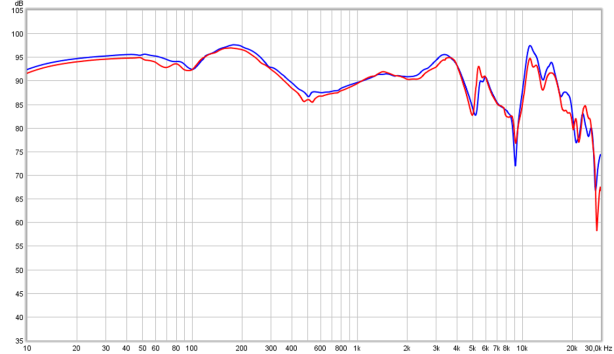
Bass extension is there. Deep rumbles can easily be heard. That is IF the seal on the ears is good. The peak at 200Hz is responsible for the muddy/boxy/hollow sound of the bass.
The upwards sloping 500Hz to 3kHz region makes the mids have a ‘clear’ character with good presence. Usually this makes the sound ‘forward’ and dynamic but the ‘muddy’ bass undoes this effect and still manages to muddy the sound.
The treble is not sharp nor elevated. Slightly subdued even which isn’t a bad thing in this case. The treble quality is not very high. It isn’t very poor either. Let’s call it a mediocre quality.
Below the distortion plots of the E40 BT: (only Right channel shown)
The distortion products are shown in dB.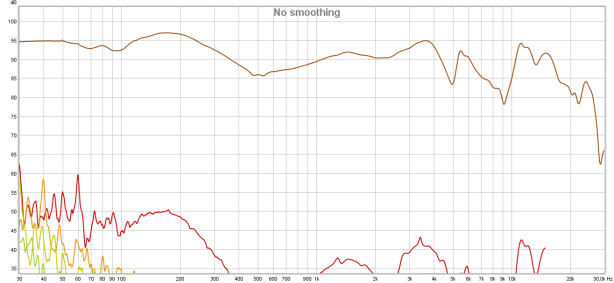
Below the same plot but the vertical scale is in percentages.
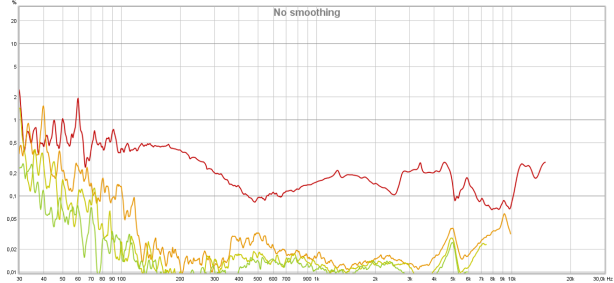
The distortion is not very high. In the 200Hz area the 2nd harmonics are a bit on the high side. Distortion in the mids and treble is actually quite good.
Not a bad performance. Too bad the tonal balance is not on par with the distortion numbers.
Below the CSD of the E40 BT (Left and Right channel are superimposed)
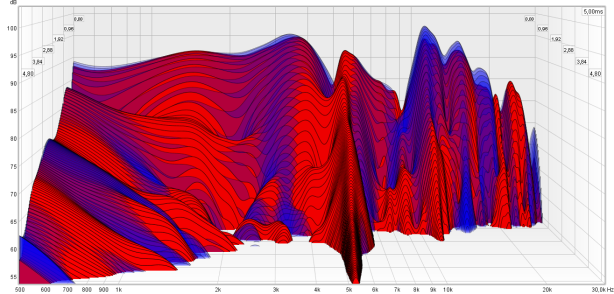
The lingering in the 500Hz region is part of the reason for the hollow/muddy character.
While the distortion of this driver is still low (just slightly elevated there) around 5kHz there is considerable ringing. The length of the ringing and frequency is far from ideal and is audible as a slight ‘edge’ in certain instruments and makes certain instruments less realistic and less ‘real’ sounding. Above 6kHz the driver seems to behave reasonably well.
Below the spectrum plot of the E40 BT.
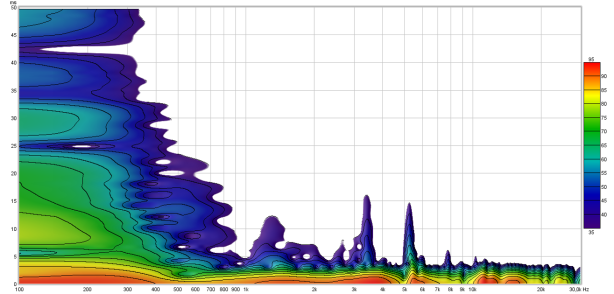
Here too the prolonged ‘energy’ in the lows is very visible. Also there is some ringing at 3.5kHz, but at a low level. At just above 5kHz the resonance is quite visible as well.
Step response plot of the E40 BT. (Left channel)
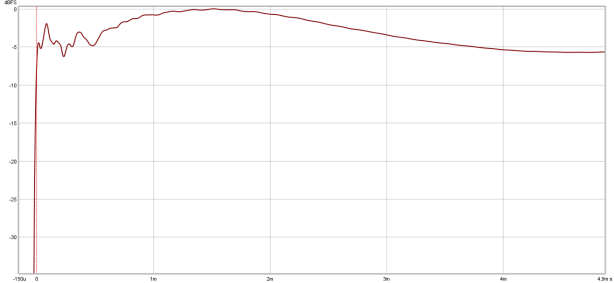
Impulse response is not that bad. The 5kHz ringing is visible as well. The hump around 1.5ms is showing the ‘hollow’ mids and muddy character. Bass extension is excellent though as the horizontal trace hardly sags and even after 5ms is still at the same level as the rising edge.
summary
When you want a good sound quality and bluetooth functionality I would certainly look elsewhere. The sound quality of this headphone is not very high.
It has good bass extension but bass quality is ‘poor’ as it is ‘muddy’. The mids are not ‘warm’ nor realistic but are clear. Instruments have a weird unreal character.
Treble quality is not great. The 5kHz ringing degrades the treble quality as do the sharp dips.
